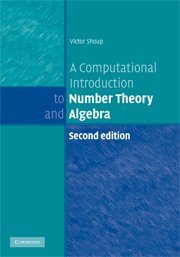Book contents
- Frontmatter
- Contents
- Preface
- Preliminaries
- 1 Basic properties of the integers
- 2 Congruences
- 3 Computing with large integers
- 4 Euclid's algorithm
- 5 The distribution of primes
- 6 Abelian groups
- 7 Rings
- 8 Finite and discrete probability distributions
- 9 Probabilistic algorithms
- 10 Probabilistic primality testing
- 11 Finding generators and discrete logarithms in ℤ*p
- 12 Quadratic reciprocity and computing modular square roots
- 13 Modules and vector spaces
- 14 Matrices
- 15 Subexponential-time discrete logarithms and factoring
- 16 More rings
- 17 Polynomial arithmetic and applications
- 18 Linearly generated sequences and applications
- 19 Finite fields
- 20 Algorithms for finite fields
- 21 Deterministic primality testing
- Appendix: Some useful facts
- Bibliography
- Index of notation
- Index
7 - Rings
Published online by Cambridge University Press: 05 February 2015
- Frontmatter
- Contents
- Preface
- Preliminaries
- 1 Basic properties of the integers
- 2 Congruences
- 3 Computing with large integers
- 4 Euclid's algorithm
- 5 The distribution of primes
- 6 Abelian groups
- 7 Rings
- 8 Finite and discrete probability distributions
- 9 Probabilistic algorithms
- 10 Probabilistic primality testing
- 11 Finding generators and discrete logarithms in ℤ*p
- 12 Quadratic reciprocity and computing modular square roots
- 13 Modules and vector spaces
- 14 Matrices
- 15 Subexponential-time discrete logarithms and factoring
- 16 More rings
- 17 Polynomial arithmetic and applications
- 18 Linearly generated sequences and applications
- 19 Finite fields
- 20 Algorithms for finite fields
- 21 Deterministic primality testing
- Appendix: Some useful facts
- Bibliography
- Index of notation
- Index
Summary
This chapter introduces the notion of a ring, more specifically, a commutative ring with unity. While there is a lot of terminology associated with rings, the basic ideas are fairly simple. Intuitively speaking, a ring is an algebraic structure with addition and multiplication operations that behave as one would expect.
Definitions, basic properties, and examples
Definition 7.1. A commutative ring with unity is a set R together with addition and multiplication operations on R, such that:
(i) the set R under addition forms an abelian group, and we denote the additive identity by 0R;
(ii) multiplication is associative; that is, for all a, b, c ∈ R, we have a(bc) = (ab)c;
(iii) multiplication distributes over addition; that is, for all a, b, c ∈ R, we have a (b + c) = ab + ac and (b + c)a = ba + ca;
(iv) there exists a multiplicative identity; that is, there exists an element 1R ∈ R, such that 1R · a = a = a · 1Rfor all a ∈ R;
(v) multiplication is commutative; that is, for all a, b ∈ R, we have ab = ba.
There are other, more general (and less convenient) types of rings–one can drop properties (iv) and (v), and still have what is called a ring. We shall not, however, be working with such general rings in this text. Therefore, to simplify terminology, from now on, by a “ring,” we shall always mean a commutative ring with unity.
- Type
- Chapter
- Information
- A Computational Introduction to Number Theory and Algebra , pp. 166 - 206Publisher: Cambridge University PressPrint publication year: 2008



